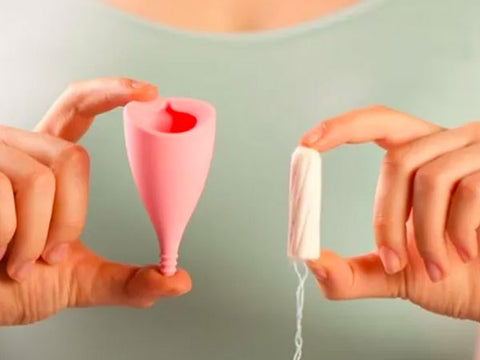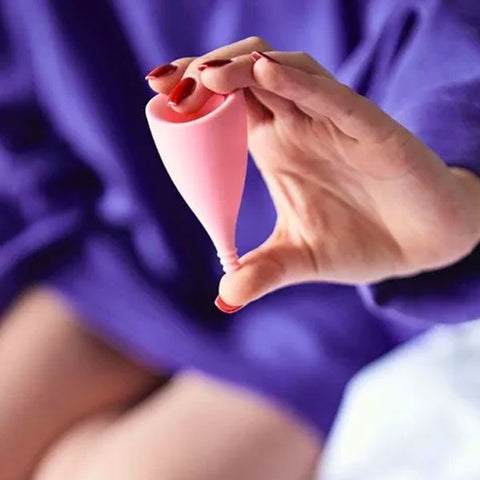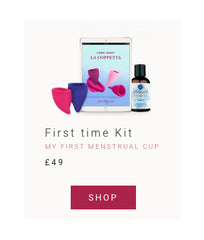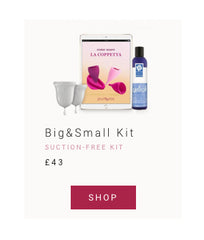Menstrual Cups for Dummies
I was a long-time skeptic when it came to menstrual cups, but I wouldn’t be able to give you an exact reason why.

Perhaps because on one hand, it troubled me to hear how some women talked about it with such a fanatic enthusiasm, demonstrating an almost cult-like approach...a collective mass exaltation that wasn’t even brought out for the clitoris-sucking sex toys.
On the other hand, while some proclaimed the “ovarian revolution”, my mind came up with various types of objections, including: What if it’s small? Or what if it’s big? And what if it’s uncomfortable? What if it bothers me? And what if it starts leaking? Or what if it grosses me out? What happens if I’m allergic to it? And the list goes on and on.
________________________________________________________________
You may also like: Cocoro, Advanced Lingerie for Periods
________________________________________________________________
The ideological arguments in support of the menstrual cup were, and are, known to be: ecology and economics. In fact, the cup is a sustainable choice when it comes to the environment - just do the math surrounding how many cycles you have had so far in life. I’ve had around 260 in my 20 reproductive years, which translates to more or less 1300 menstruation days, and roughly 6500 sanitary napkins that absorbed just my menstruation fluids. Further, the cup is also a clear budget-friendly choice, because it requires only a one-time, initial investment, thus absolving you from the “sin” of the 22% tax on what are clearly not luxury goods, yet are taxed like them all the same. Hurray, rejoice, champagne.

Even so, I still wasn’t convinced, until I read a book on the taboo of menstruation just a few months ago. I learned that in normal sanitary napkins - those that most of us use and have seen on television for the past thirty years, with or without wings, long, very long, compact, with patterns, perfumes, and inspirational phrases written on them; those as smooth as a petal, reliable even if you decide to go parachuting, soft as a memory foam mattress; invisible; undetectable; odorless - basically, those products from big companies with large-scale, organized distribution (not to mention the worst, Tampax), those very same sanitary napkins contain everything. EVERYTHING, except cotton, that is.
As if that information wasn’t enough, their production is not controlled by any sort of health authority (I don’t know if something has changed in the last few months at the legislative level, but I wouldn’t count on it). Then, I learned about TSS: Toxic Shock Syndrome, the reason why American supermodel, Lauren Wasser, needed to have a leg amputated in 2012, and the reason why in 2013, a sixteen year old died in France because her tampon had not been changed for twenty hours. I repeat: she died. In 1980, there were 38 deaths from TSS in the United States.

The materials in our dear sanitary napkins have been made public, thanks to laboratory analysis carried out in recent years by menstrual activists. These ingredients include anywhere from 20 to 30 different chemical components, endocrine disruptors, up to 90% plastic, carcinogenic materials, dioxin, traces of pesticides, and other elements capable of destroying the vaginal flora. The materials are never shown on the packaging label. It’s actually easier to know what’s inside of a tube of lipstick than knowing what’s contained in the little white “sausage” placed into our delicate, precious vaginal cavity, where it is in contact with our most intimate mucous membranes for hours on end.
So, as I was reading, I promised myself that one of my personal goals for the Autumn would be to overcome my hesitations and explore new menstrual frontiers...the first of which is the Menstrual Cup (made of body-safe, Medical Grade silicone)!
+ Discover cups and intimate hygiene
After discussing my options with pureeros, which offers different types, I received my First Time Kit. This kit comes with two cups (each cup is a different size, so that you can choose the one that best suits your own “size” and your specific flow), a soft antibacterial case to take it with you on-the-go, an organic lubricant for the first applications, and a detailed user guide. In short, it’s a menstrual cup for dummies - exactly what I needed!
I must admit, I liked the cup at first glance because of its colors and material. I decided to start with the fuschia Size A cup, and I sterilized it in a saucepan with boiling water for three minutes, as instructed. Afterwards, I took it out, dried it, and then I sat on my toilet while launching it into orbit, with the same look that I normally had with Tampax, but mixed with a shiver of uncertainty and curiosity, all sparked by the unfamiliar.
With my second attempt, the mission was a success. For the first fifteen seconds I felt nauseous at the realization that something non-phallic had been inserted into my body. Then, for the first thirty seconds, I really felt it, just as I had felt during my first few times wearing tampons. After one minute, though, I had completely forgotten that I was wearing it...or rather...that it was inside of me.

The cup can be worn for up to twelve hours. However, I was brought back to reality after a few hours with the all-too-familiar feeling of dampness, due to a leak. Maybe I hadn’t inserted it well, or maybe I should have used the other size. With pureeros, I realized that there are several factors to consider when choosing the appropriate menstrual cup, including the height of the cervix. This helps determine whether a shorter or longer cup would work better!
I did not give up, though! In fact, most of the testimonials I had read and heard about made it clear that you should give yourself up to two to three cycles to master the art. (It’s certainly more difficult to use compared to disposable devices. It’s not rocket science, though). For this reason, the Kits are convenient for those of us who are just starting out, because having two sizes for the price of one allows you to choose the best fit.
In any case, I found myself at the most pivotal and frightening moment: removing the Holy Grail. To my surprise, though, everything went smoothly and I managed not to turn the bathroom into a crime scene. Of course, it cannot be denied that there is a splash factor to take into account. On a very trivial note, we’re just not used to seeing our menstrual blood like this, but I think it’s a pure and simple practice--a habit, if you will.

As of now, I still do not consider myself as an official menstrual-cup-convert. I’m still not able to rely on them all the time, while upside down, hanging on one leg, or in public toilets. Basically, it’s a partial solution for me. However, I would come back to it in the future, especially when it comes to alternative and integrative devices - even for those who just don’t like the cup (hey, it happens), for those who haven’t found it to be the best solution, or for those like me, who are still getting to know it.
Nevertheless, the fact remains that I am t-h-r-i-l-l-e-d to have tried this, to have discovered its feasibility, and to have started practicing a healthier, more ecological, and more budget-friendly method of living with my menstruation.
And yes, I think it’s really worth a shot!




